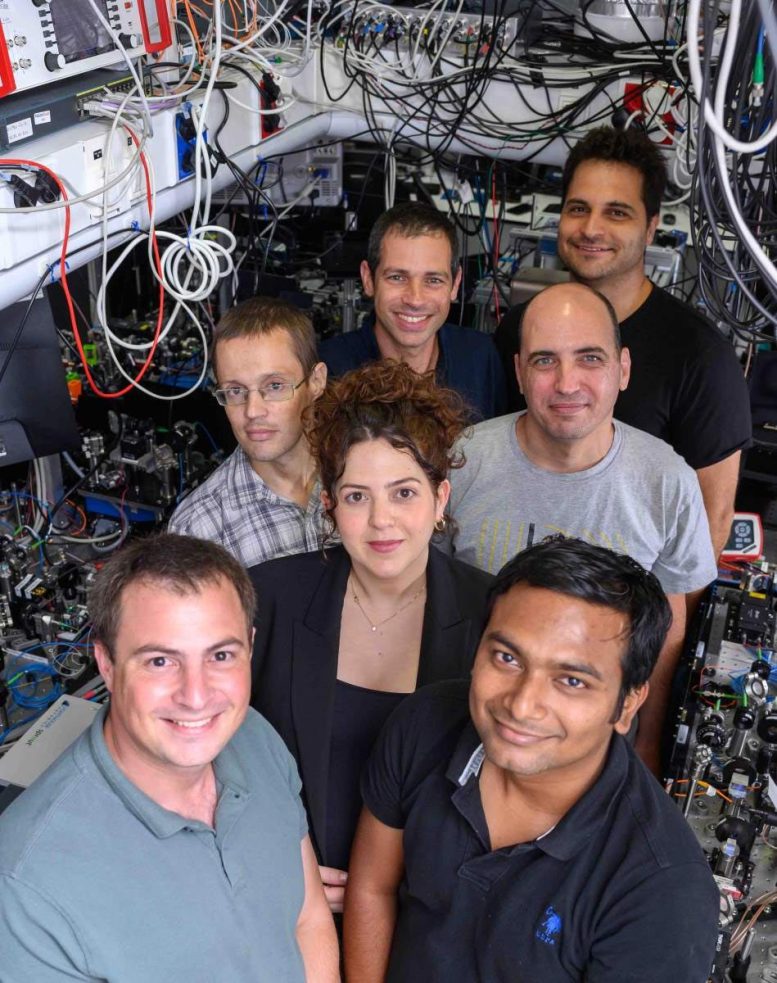The Swirl of Light Revolutionizing Quantum Computing


A novel vortex phenomenon involving photon interactions was identified by scientists, potentially enhancing quantum computing. Through experiments with dense rubidium gas, they observed unique phase shifts that mimic other vortices but are distinct in their quantum implications. Credit: SciTechDaily.com
A new study of photons in quantum computing made a surprising discovery: When photons collide, they create vortices.
Researchers at the Weizmann Institute of Science discovered a new type of vortex formed by photon interactions, which could advance quantum computing.
Vortex Phenomena
Vortices are a widespread natural phenomenon, observable in the swirling formations of galaxies, tornadoes, and hurricanes, as well as in simpler settings like a stirring cup of tea or the water spiraling down a bathtub drain. Typically, vortices arise when a rapidly moving substance such as air or water meets a slower-moving area, creating a circular motion around a fixed axis. Essentially, vortices serve to reconcile the differences in flow speeds between adjoining regions.

A vortex ring and lines created by the influence of three photons on one another. The color describes the phase of the electric field, which completes a 360-degree rotation around the vortex core. Credit: Weizmann Institute of Science
Discovery of a New Vortex Type
A previously unknown type of vortex has now been discovered in a study, published in Science, conducted by Dr. Lee Drori, Dr. Bankim Chandra Das, Tomer Danino Zohar, and Dr. Gal Winer from Prof. Ofer Firstenberg’s laboratory at the Weizmann Institute of Science’s Physics of Complex Systems Department. The researchers set out to look for an efficient way of using photons to process data in quantum computers and found something unexpected: They realized that in the rare event that two photons interact, they create vortices. Not only does this discovery add to the fundamental understanding of vortices, it may ultimately contribute to the study’s original goal of improving data processing in quantum computing.
Photon Interactions and Quantum Computing
The interaction between photons – light particles that also behave like waves – is only possible in the presence of matter that serves as an intermediary. In their experiment, the researchers forced photons to interact by creating a unique environment: a 10-centimeter glass cell that was completely empty, save for rubidium atoms that were so tightly packed in the center of the container that they formed a small, dense gas cloud about 1 millimeter long. The researchers fired more and more photons through this cloud, examined their state after they had passed through it, and looked to see if they had influenced one another in any way.
When the gas cloud was at its densest and the photons were close to each other, they exerted the highest level of mutual influence.
Dynamic Interactions in Dense Gas Clouds
“When the photons pass through the dense gas cloud, they send a number of atoms into electronically excited states known as Rydberg states,” Firstenberg explains. “In these states, one of the electrons in the atom starts moving in an orbit that is 1,000 times wider than the diameter of an unexcited atom. This electron creates an electric field that influences a huge number of adjacent atoms, turning them into a kind of imaginary ‘glass ball.’”
The image of a glass ball reflects the fact that the second photon present in the area cannot ignore the environment the first photon has created and, in response, it alters its speed – as if it has passed through glass. So, when two photons pass relatively close to each other, they move at a different speed than they would have if each had been traveling alone. And when the speed of the photon changes, so does the position of the peaks and valleys of the wave it carries. In the optimal case for the use of photons in quantum computing, the positions of the peaks and valleys become completely inverted relative to one another, owing to the influence the photons have on each other – a phenomenon known as a 180-degree phase shift.

From bottom left, clockwise: Dr. Lee Drori, Tomer Danino Zohar, Dr. Alexander Poddubny, Prof. Ofer Firstenberg, Dr. Gal Winer, Dr. Eilon Poem and Dr. Bankim Chandra Das. Credit: Weizmann Institute of Science
Pioneering Research in Photon Dynamics
The direction that the research took was as unique and extraordinary as the paths of the photons in the gas cloud. The study, which also included Dr. Eilon Poem and Dr. Alexander Poddubny, began eight years ago and has seen two generations of doctoral students pass through Firstenberg’s laboratory.
Over time, the Weizmann scientists managed to create a dense, ultracold gas cloud, packed with atoms. As a result, they achieved something unprecedented: photons that underwent a phase shift of 180-degrees – and sometimes more. When the gas cloud was at its densest and the photons were close to each other, they exerted the highest level of mutual influence. But when the photons moved away from each other or the atomic density around them dropped, the phase shift weakened and disappeared.
The Surprising Behavior of Photon Vortices
The prevalent assumption was that this weakening would be a gradual process, but researchers were in for a surprise: A pair of vortices developed when two photons were a certain distance apart. In each of these vortices, the photons completed a 360-degree phase shift and, at their center there were almost no photons at all – just as in the dark center we know from other vortices.
The scientists found that the presence of a single photon affected 50,000 atoms, which in turn influenced the motion of a second photon.
Insights Into Photon Vortex Dynamics
To understand photon vortices, think of what happens when you drag a vertically held plate through the water. The rapid movement of the water pushed by the plate meets the slower movement around it. This creates two vortices that, when viewed from above, appear to be moving together along the water’s surface, but in fact, they are part of a three-dimensional configuration known as a vortex ring: The submerged part of the plate creates half a ring, which connects the two vortices visible on the surface, forcing them to move together.
Another familiar instance of vortex rings is smoke rings. In the last stages of the study, the researchers observed this phenomenon when they introduced a third photon, which added an extra dimension to the findings: The scientists discovered that the two vortices observed when measuring two photons are part of a three-dimensional vortex ring generated by the mutual influence of the three photons. These findings demonstrate just how similar the newly discovered vortices are to those known from other environments.
Advancements Toward Quantum Data Processing
The vortices may have stolen the show in this study, but the researchers are continuing to work toward their goal of quantum data processing. The next stage of the study will be to fire the photons into each other and measure the phase shift of each photon separately. Depending on the strength of the phase shifts, the photons could be used as qubits – the basic units of information in quantum computing. Unlike the units of regular computer memory, which can either be 0 or 1, quantum bits can represent a range of values between 0 and 1 simultaneously.
Reference: “Quantum vortices of strongly interacting photons” by Lee Drori, Bankim Chandra Das, Tomer Danino Zohar, Gal Winer, Eilon Poem, Alexander Poddubny and Ofer Firstenberg, 13 July 2023, Science.
DOI: 10.1126/science.adh5315
Prof. Ofer Firstenberg’s research is supported by the Leona M. and Harry B. Helmsley Charitable Trust, the Shimon and Golde Picker – Weizmann Annual Grant and the Laboratory in Memory of Leon and Blacky Broder, Switzerland.


